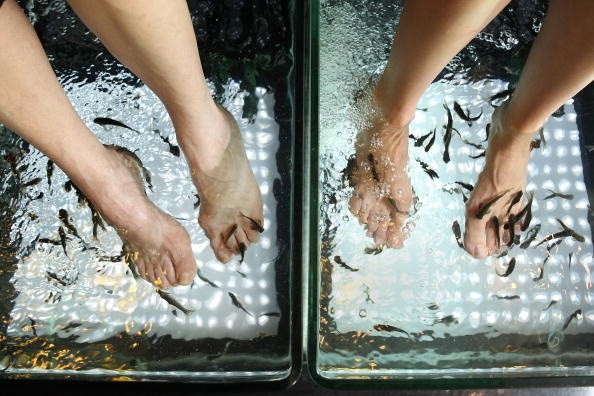Fish pedicuring is a spa process that involves dipping the feet in a basin of water filled with supposed doctor fishes. These fishes, also known as Garra rufa, will feed on the dead skin, paving the way for a fresher, smooth, and callous-free skin.
This non-painful procedure originates from Turkey and is used widely in other Middle Eastern countries. The Garra rufa fishes, a native of the middle east and south Asian countries, are mostly used for this foot spa and pedicure.
Due to the serious health risk that might be associated with fish pedicuring, this unethical beauty practice is banned in many states in the United States, Europe, and Canada. Fish spa is cited as being unhealthy and also seen as cruelty to the fishes that are forced to feed on human dead skin due to lack of food after being severely starved.

If you're planning on experiencing a fish pedicure, consider these things first. There are several disadvantages of fish pedicure:
1. High Risk of Infection
Your amazing spa session can easily turn into a disease or infection contracting session with just the thinnest cut that exposes the dermal part of your skin. These fishes used during pedicures are not trained to avoid giving cuts on your skin.
They only feed on the dead skin and might go deep enough to cause a cut, and this makes you prone to different types of diseases.
According to experts, the Garra rufa fish commonly used in fish spas are active agents of bacterial strain Streptococcus Agalactaie group B, this bacteria can cause several deadly infections like pneumonia, bone, joint infection, and bloodstream infections, according to The Health Site.
Also, most people find it difficult to differentiate the Garra rufa fish from other species of fish like the Chinchin, which can grow teeth and bite, causing pain and increasing the risk of infection.
2. Nail Trauma
Onychomadesis is a condition where the toenails blacken and eventually fall off. This condition is caused by trauma to the nail during fish sparring; these fishes severely injure the toenails during sparring.
What makes it much scarier is that you can't detect this condition immediately after sparing as it is not painful, and also the injuries are not noticeable until your nails start to grow after 3 to 6 months. These fishes affect the nail palate's production of toenails resulting in onychomadesis.
3. Exposure to Skin Plaque
The tubs in which these fishes breed are primarily breeding grounds for different infections and bacteria. Although there is constant changing of water during sanitization, there is no assurance that these fishes are bacteria-free because they are not sanitized themselves.
Different infections have been recorded during this sparing, this include the mycobacteriosis, a bacterial infection resulting in rough plaque on the skin, atleast one case has been reported after a fish pedicure.

4. Fish Starvation
Making Garra rufa fish starve for days to enable them get rid of your dead skin, thereby giving you smooth and soft feet or palms is inhumane. The fishes don't like eating your dead skin. But they eat them because they are very hungry and need to survive.
Before involving yourself in this pedicure activities it is important to study more risks associated with it to avoid pending health dangers and challenges in the future.
Related Article : Talking Fish: New Study Shows Some Fishes Produce Sounds to Communicate
For more news, updates about fishes and similar topics don't forget to follow Nature World News!
© 2025 NatureWorldNews.com All rights reserved. Do not reproduce without permission.





